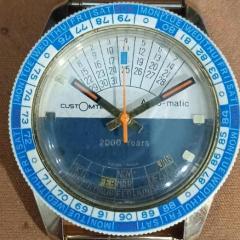-
Recently Browsing
- No registered users viewing this page.
-
Topics
-
Posts
-
I visited the Breguet Exhibition today. https://www.sciencemuseum.org.uk/about-us/press-office/rare-timepieces-unveiled-new-display-science-museum The Science Museum now holds the collection of "The Worshipful Company of Clockmakers" - "The collection includes more than 600 watches, 90 clocks, 30 marine chronometers and a number of fine sundials and examples of hand engraving, mapping the history of innovation in watch and clock making in London from 1600 to the present day." It's well worth a visit. They have some amazing pieces by the likes of Harrison, Breguet, Tompion etc . I've visited twice before but decided to go and see the Breguet Exhibition. Maybe I was expecting too much, as on reflection, "More than 20 extraordinary timepieces designed by inventor and watchmaker Abraham-Louis Breguet " isn't going to take up that much space. In reality, it's just one cabinet. But, Oh those watches, stunning 🤩 , e.g. (No 1297 was made for George III and is valued about £1m) I tried a couple of pics, but with subdued lighting and taking through glass, they aren't good. I like thin hands on a watch - how about these (I think this is a split second chrono) And this one, with all it's complications, is only 10mm thick ! What I found very interesting were a few very old machines for making watch parts, like this 17th Century gear cutter. The disc below has concentric rings with holes in, so that is can be set to cut varying teeth numbers.
-
Firstly sorry for poor image quality I only have an iPhone for photos. Im working on a 512 movement and I’ve had some trouble with the “jewels”. I’ve got the metal one out, but when I tried to put it back the three sides of the spring seem to need pressing all at once to fit it as there are three “holes”. I get two corners in but as I go for the third the first two pop out! Constantly I’ve lost the spring. I’ve done the similar ones on seiko movements without trouble. Assuming I find it/a replacement, what am I missing! on the other side with the only ruby in the movement is a setting with no “gap”at all. How do I get the spring out, and of course get it back in! What am I missing! thanks in advance. Rob
-
Links like that are the reason I routinely donate to the Internet Archive - they are the last safe house for a tremendous amount of useful info that is otherwise lost.
-
By nevenbekriev · Posted
There must be a ring around the movement that is not a part of the case and the movement will get out together with the ring.
-








Recommended Posts
Join the conversation
You can post now and register later. If you have an account, sign in now to post with your account.
Note: Your post will require moderator approval before it will be visible.